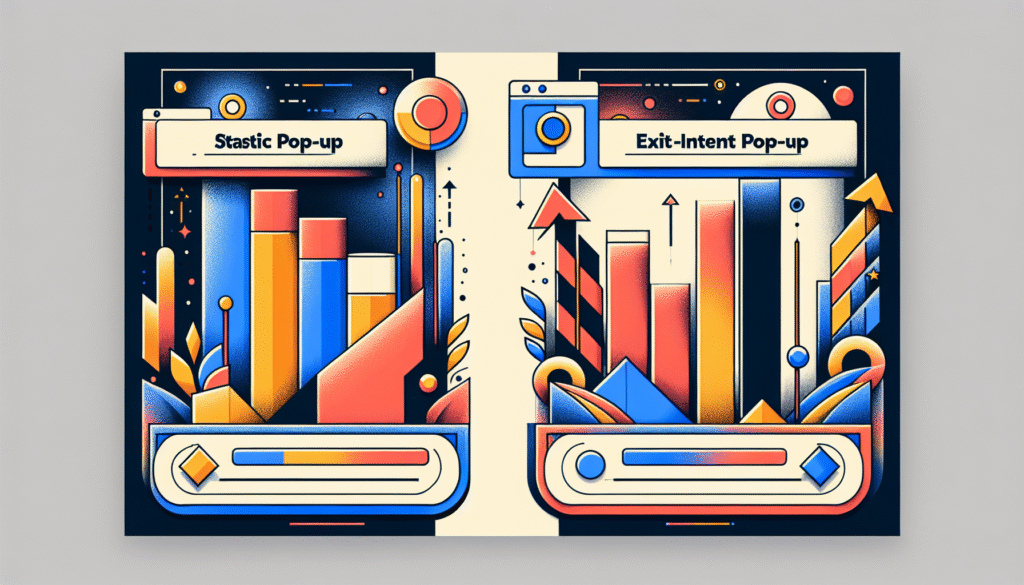Have you ever wondered which type of popup is more effective in capturing signups, static or exit-intent? Navigating the digital marketing world often feels like trying to find a new restaurant in a city you’ve never visited, with numerous paths and options available. Popups are one of these options, promising increased signups and engagement, but not all popups are created equal. Let’s chat a bit about the nuances of static versus exit-intent popups, and see if we can uncover which one truly delivers the goods.

Understanding Popups: A Brief Introduction
Before we dive into the specifics of static and exit-intent popups, it’s helpful for us to establish why popups matter in the first place. They’re our chance to capture attention, the digital equivalent of waving down a friend across a crowded room.
Why Use Popups?
Popups serve as immediate calls to action. They might offer a discount, nudge you toward a newsletter, or invite feedback. Their goal? Encourage the visitor to take a step forward. However, overuse or misuse can be overwhelming. By understanding their purpose, we create an experience, not an interruption.
Static Popups: A Steady Presence
Static popups are like the reliable friend who’s always there, waiting patiently for us to notice their presence. They’re the constant reminders, appearing after a fixed period or as soon as one lands on a webpage.
The Mechanics of Static Popups
Static popups appear using pre-defined triggers. Think time-based, scroll-dependent, or on specific page visits. When done right, they are predictable and dependable, ensuring that a visitor receives a clear message without any sudden surprises.
Benefits of Static Popups
Consistency is the charm of static popups. They are compatible with various browser conditions and maintain a steady conversion rate due to their dependable nature.
- Predictability: Users come to expect these popups and are prepared to interact.
- Versatility: Suitable for various scenarios, they can be placed anywhere in the user journey.
- Visibility: They appear promptly and can ensure maximum visibility for vital messages.
Drawbacks of Static Popups
Their very predictability can be their downfall. Everyone knows they’re coming and that can lead to a phenomenon similar to that of elevator music—briefly noticed and quickly ignored.
- Overuse: Frequent appearance can lead to banner blindness, causing users to ignore them.
- Disruption: They might interrupt the user’s flow or pathway on the site.

Exit-Intent Popups: Timely Interventions
Exit-intent popups are the charming rogue who sweeps in at the last possible moment, capturing your attention when you were just about to move on. These popups detect when a user is about to leave a website and then spring into action.
How Exit-Intent Popups Work
Exit-intent technology tracks user behavior, such as mouse movements towards the browser bar, and promptly triggers a popup at this indication of departure.
Benefits of Exit-Intent Popups
Exit-intent popups offer the chance to win back a visitor just before they leave. It’s like catching someone’s eye before they exit a party, and briefly convincing them to stay for just one more dance.
- Timely: Serve as the last line of engagement.
- Re-engagement: Provide one last chance to convert an abandoning visitor.
- Less Intrusive: Instead of disrupting the experience, they wait until it’s almost over to intervene.
Drawbacks of Exit-Intent Popups
Sometimes, if the timing isn’t just right, they lose their charm. If an exit-intent popup isn’t perfectly timed, it may irk rather than engage.
- Timing Sensitivity: Incorrect timing can result in frustration.
- Limited Use: Not effective for capturing attention proactively, only reactively.
Static Vs. Exit-Intent Popups: The Comparison
Now, let’s take a more analytical approach, laying out these two on a table, much like one might compare the merits of cake flavors, to see which holds the greater promise for increasing signups.
| Aspect | Static Popups | Exit-Intent Popups |
|---|---|---|
| Appearance Timing | Pre-set triggers, always the same moment | Just as a user is about to leave |
| User Experience | Can be disruptive if ill-timed or overused | Less intrusive, aims to re-engage |
| Conversion Hook | Initial engagement of users on page | Last-chance engagement before departure |
| Predictability | Highly predictable | Predictable only when intention to leave is detected |
| Purpose | To inform or engage proactively | To salvage potential loss reactively |
The Impact on Signup Rates
Ultimately, the effectiveness of popups comes down to numbers. Like leafing through performance reviews, we look at conversion rates and customer engagement to see which shines brightest in terms of signups.
Static Popup Effectiveness
When well-executed, static popups perform reliably. They’re like a steady pulse, consistently converting a portion of visitors into signups:
- Consistency: Provides stable results over time.
- Steady Rates: Offers reliable signup figures without significant fluctuations.
Exit-Intent Popup Effectiveness
Exit-intent popups often present a slightly higher conversion rate, acting as a final lifeline to reel users back in:
- Higher Conversion Potential: By catching abandonment, they often convert more effectively per encounter.
- Engagement Boost: Encourages users to reconsider leaving, impacting the bounce rates positively.
Crafting the Perfect Popup Strategy
So, which wins this epic showdown? Often, the answer isn’t perfectly clear-cut. Much like pairing wines with meals, the strategy needs to be tailored to the audience and context of use.
Mixing Strategies for Best Results
Combining the strengths of both static and exit-intent popups may be beneficial to create an adaptable strategy that covers all grounds:
- Layered Approach: Utilize static popups earlier in the user journey, with exit-intent popups on standby.
- Segmentation: Analyze user behavior to tailor the type and timing of popups.
A/B Testing: The Experimental Canvas
We advocate experimenting—testing different styles, timings, and messaging to see what resonates best with your audience. Think of it like trying out different toppings on a pizza—experiment and find what satisfies the most.
- Metrics Analysis: Ensure that analytic tools are in place to measure the success of each popup approach.
- Iterative Improvements: Use findings to refine and adjust strategies.
Our Conclusion
In the end, effectiveness is contingent upon context, execution, and the ability to adapt based on audience needs. Popups, whether static or exit-intent, are at their best when used thoughtfully and with the user journey in mind. By being attentive and strategic in our choices, we can more effectively guide users toward that coveted sign-up button. Ever looked across a crowded room, locked eyes, and thought “Yes, this is the moment”? That’s the essence of a well-timed popup. As long as we remember to listen, observe, and adapt, we’re on the path to conversion success.
